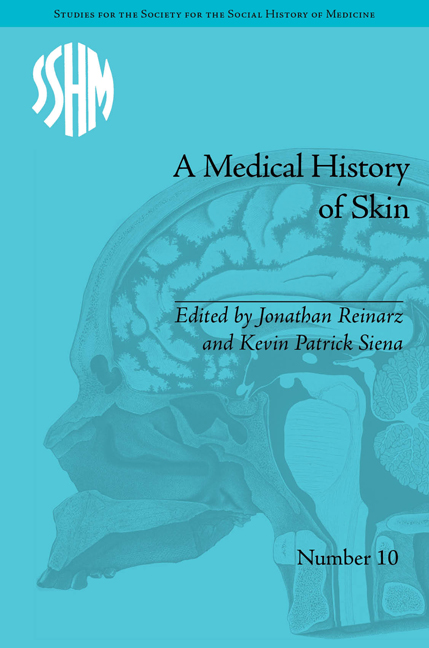Book contents
- Frontmatter
- CONTENTS
- List of Contributors
- List of Figures and Tables
- Scratching the Surface: An Introduction
- Part I The Emerging Skin Field
- Part II Skin, Stigma and Identity
- Part III Skin, Disease and Visual Culture
- 9 ‘An Alteration in the Human Countenance’: Inoculation, Vaccination and the Face of Smallpox in the Age of Jenner
- 10 Portraying Skin Disease: Robert Carswell's Dermatological Watercolours
- 11 Atavistic Marks and Risky Practices: The Tattoo in Medico-Legal Debate, 1850–1950
- 12 ‘Kissed by the Sun’: Tanning the Skin of the Sick with Light Therapeutics, c. 1890–1930
- 13 ‘Classic, Characteristic or Typical’: The Skin and the Visual Properties of External Anthrax Lesions
- Afterword: Reading the Skin, Discerning the Landscape: A Geo-historical Perspective of our Human Surface
- Notes
- Index
11 - Atavistic Marks and Risky Practices: The Tattoo in Medico-Legal Debate, 1850–1950
from Part III - Skin, Disease and Visual Culture
- Frontmatter
- CONTENTS
- List of Contributors
- List of Figures and Tables
- Scratching the Surface: An Introduction
- Part I The Emerging Skin Field
- Part II Skin, Stigma and Identity
- Part III Skin, Disease and Visual Culture
- 9 ‘An Alteration in the Human Countenance’: Inoculation, Vaccination and the Face of Smallpox in the Age of Jenner
- 10 Portraying Skin Disease: Robert Carswell's Dermatological Watercolours
- 11 Atavistic Marks and Risky Practices: The Tattoo in Medico-Legal Debate, 1850–1950
- 12 ‘Kissed by the Sun’: Tanning the Skin of the Sick with Light Therapeutics, c. 1890–1930
- 13 ‘Classic, Characteristic or Typical’: The Skin and the Visual Properties of External Anthrax Lesions
- Afterword: Reading the Skin, Discerning the Landscape: A Geo-historical Perspective of our Human Surface
- Notes
- Index
Summary
The history of the tattoo in Western civilization has received sporadic and incomplete scholarly attention going back as far as the first century AD, according to some sources. Writing in 1869, the French naval surgeon Ernest Berchon cites a number of early works on methods of tattoo removal, of which Archigenes (AD 97) appears the earliest. Indeed, if it were not for the researches of medical professionals and criminologists from the mid-nineteenth century onwards, the history of tattooing in Europe and North America during this period would be considerably more opaque. The sudden effusion of publications in medical, military and criminological journals from c. 1850 into the early twentieth century reveals the emergence of strong scholarly interest in tattooing. These studies focused predominantly upon typically segregated social milieux – the hospital, barracks and prison – contexts that provided ample opportunity for research to be carried out amongst isolated populations. Occasionally, they also analysed tattoos of colonized peoples. But they mainly concerned tattoos of soldiers or sailors, or else of social ‘deviants’ – prostitutes, criminals or those whose reckless behaviour led them to a clinic for treatment.
Whilst there was often overlap between disciplinary fields, particularly within the developing disciplines of criminology or forensic science and the medical sciences, it is important to note the distinctions between discourses emerging from different geographical locations. For instance, historian Jane Caplan has pointed out that whilst there was a great deal of interest in the tattoo in continental European criminological debate, this preoccupation did not extend across the channel to Britain.
- Type
- Chapter
- Information
- A Medical History of SkinScratching the Surface, pp. 165 - 180Publisher: Pickering & ChattoFirst published in: 2014



